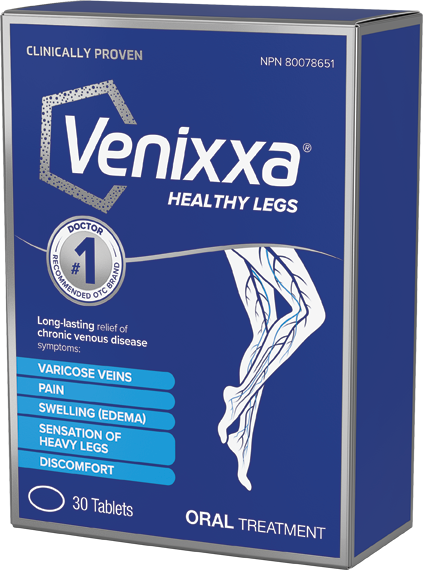We’ve all had to make unforeseen adjustments in 2020 due to the COVID-19 pandemic, many of those having to do with work.
Whether you work in an essential occupation and have had to spend more hours on your feet, more time at home due to work stoppages or have had to adjust to an awkward work-from-home setup, it’s likely your routine has been disrupted.
Check in with your limbs
Take a second right now to check in with yourself, and think about a part of your body that you might not give much thought, but that give you so much support: your legs. Have you noticed any slight changes in how your legs have been feeling? Have you been spending more time than usual standing, or sitting in strange positions? Do your legs feel swollen or painful at the end of the day?
“I didn’t think too much of it,” says Lesley McVean from Oakville, Ontario. “I used to work in occupations that kept me on my feet for decades. I told myself the symptoms were probably just fatigue or normal signs of aging.”
In 2017, McVean was experiencing pain and swelling in her legs. These symptoms she experienced grew in intensity, yet she didn’t realize they were in fact signs of a greater, more serious health condition.
Recognizing Chronic Venous Disease
They were actually symptoms of chronic venous disease. This sneaky condition occurs when your leg veins become less efficient, and stop pumping blood back to your heart effectively. This causes the blood to collect in your legs, which is what triggers the soreness and inflammation.
“There are telltale signs to look out for, including varicose and spider veins, a heavy, swollen feeling in your legs, and discomfort during physical activity,” says Dr. Beverley Chan, vascular surgeon at Vascular Health Bronte. “Left untreated, those symptoms can get worse, making everyday things like showering, driving to get groceries or even just taking a walk pretty uncomfortable.” “Not only that,” she adds. “Some people end up doing serious harm to the veins in their legs, damaging the skin and pigmentation and even developing an ulcer that requires long-term treatment.”
If you didn’t realize that simple symptoms like leg soreness and swelling, or even heavy legs, are signs of chronic venous disease, you’re not alone. While a substantial 75 per cent of Canadian women aged 35 to 60 have experienced at least one symptom of chronic venous disease, thousands of them don’t know what the disease is, or how it might be affecting them.
Simple changes toward relief
While navigating the new normal of your life in the pandemic, whether that’s working from home or staying around the home more, or putting in extra hours on your feet, there are small adjustments you can make to help find relief from chronic venous disease symptoms.
If you’re working from home, know that moderation is important. Neither sitting nor standing for long periods of time is ideal, especially in makeshift settings. Dr. Chan recommends to make adjustments accordingly.
“When it comes to working from home, everyone has a different style,” says Dr. Chan. “Some people like staying busy from the comfort of the couch. If that’s your thing, try to keep your legs elevated to help reduce swelling and increase blood flow.”
Another way to break up periods of sitting and standing while working at home is to stand while taking calls or when typing for longer, uninterrupted stretches.
She continues, “Standing desks are definitely on-trend and have many proven benefits, but do bear in mind that being on your feet for long periods can cause blood pooling in the legs and increase vein pressure, too.”
For those required to be on their feet for long periods of time with a less flexible workday outside of the home, it’s important to take frequent breaks from standing. Inform your supervisor of your leg condition, if necessary.
Regardless of whether you’re working at home, not working, or working more outside the home, it’s important to maintain a nutritious and balanced diet that keeps your body nourished and hydrated. Fruits and vegetables, whole grains, high fibre foods and lots of water can help maintain a balanced intake.
Treating the cause and the symptoms
A number of years previously, Lesley McVean had a benign lump removed from her leg. When she began experiencing symptoms of chronic venous disease—swelling and pain—her first thought was that the lump had returned. McVean underwent surgery and a series of injection treatments. Following this, her doctor recommended using Venixxa to continue to treat her condition.

“I coped with many nasty symptoms of chronic venous disease for years, and it put me through a lot,” says McVean. “For me, finding Venixxa was such a huge relief.”
Made from a key active ingredient that occurs naturally in immature oranges that’s extracted and processed through a specialized and patented procedure, Venixxa is a convenient, over-the-counter oral treatment that can help relieve symptoms of mild to moderate chronic venous disease. You can learn more on how Venixxa is made here.
McVean continues, “Venixxa gave me a quick break from the swelling and pain, which I didn’t realize was an internal problem, especially since I had spent many hours a day on my feet for years. Today, after taking Venixxa for a few years, I’m symptom free. And while I might not be 20 anymore, I even feel good about showing a little leg on warmer days again!”
Not only does it relieve symptoms, when used over a couple of weeks, Venixxa is shown to improve circulation and significantly reduce pain, lower-leg swelling and heaviness in just eight weeks.
If any of the symptoms mentioned feel familiar to you, it could be that you are at risk of or currently experiencing chronic venous disease. It’s best to act fast before symptoms worsen or further damage is done. Assess your risk of suffering from chronic venous disease by trying our veinscore tool now.

